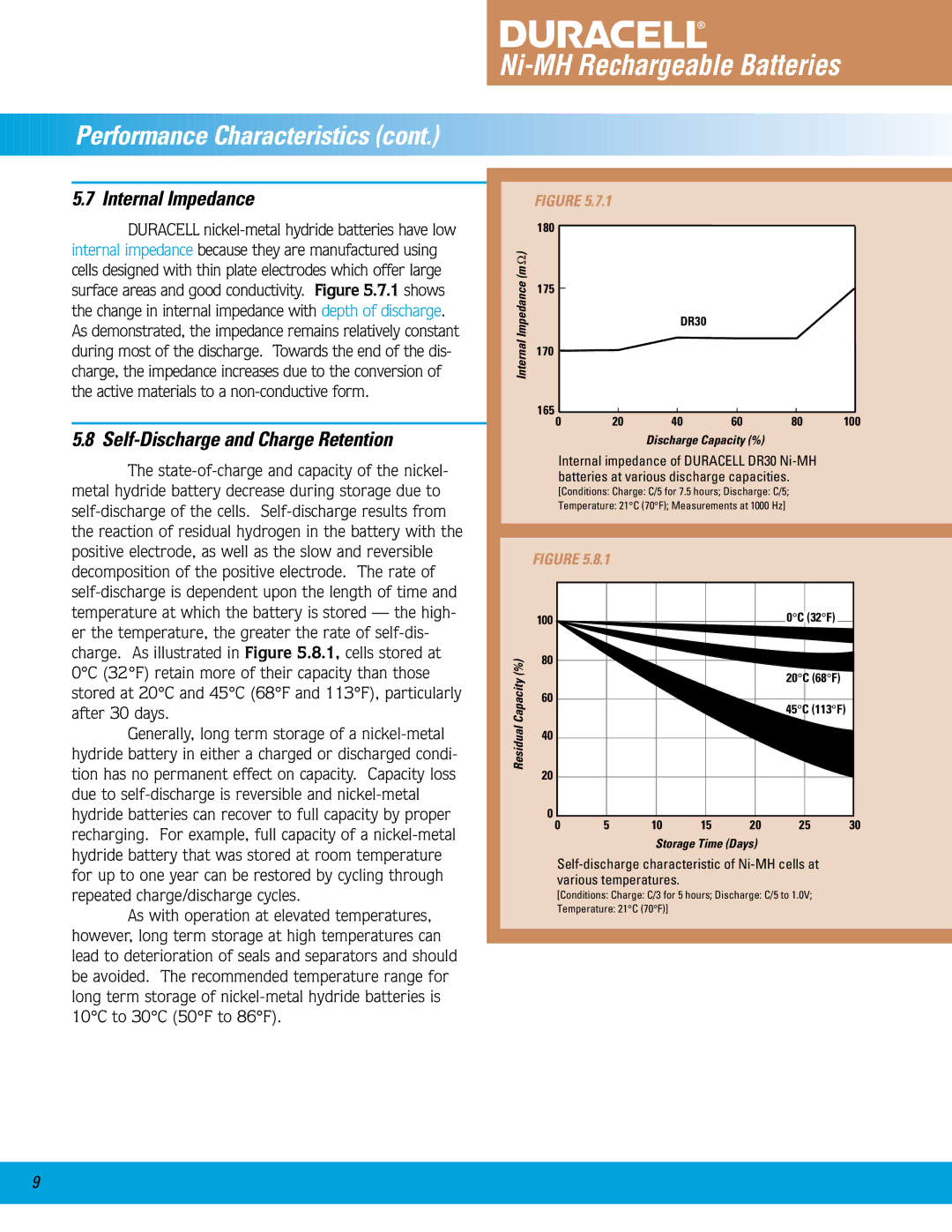






 Performance
Performance Ch
Ch
 aracteristics
aracteristics (cont.)
(cont.)






5.7 Internal Impedance
DURACELL nickel-metal hydride batteries have low internal impedance because they are manufactured using cells designed with thin plate electrodes which offer large surface areas and good conductivity. Figure 5.7.1 shows the change in internal impedance with depth of discharge. As demonstrated, the impedance remains relatively constant during most of the discharge. Towards the end of the dis- charge, the impedance increases due to the conversion of the active materials to a non-conductive form.
5.8 Self-Discharge and Charge Retention
The state-of-charge and capacity of the nickel- metal hydride battery decrease during storage due to self-discharge of the cells. Self-discharge results from the reaction of residual hydrogen in the battery with the positive electrode, as well as the slow and reversible decomposition of the positive electrode. The rate of self-discharge is dependent upon the length of time and temperature at which the battery is stored — the high- er the temperature, the greater the rate of self-dis- charge. As illustrated in Figure 5.8.1, cells stored at 0°C (32°F) retain more of their capacity than those stored at 20°C and 45°C (68°F and 113°F), particularly after 30 days.
Generally, long term storage of a nickel-metal hydride battery in either a charged or discharged condi- tion has no permanent effect on capacity. Capacity loss due to self-discharge is reversible and nickel-metal hydride batteries can recover to full capacity by proper recharging. For example, full capacity of a nickel-metal hydride battery that was stored at room temperature for up to one year can be restored by cycling through repeated charge/discharge cycles.
As with operation at elevated temperatures, however, long term storage at high temperatures can lead to deterioration of seals and separators and should be avoided. The recommended temperature range for long term storage of nickel-metal hydride batteries is 10°C to 30°C (50°F to 86°F).
FIGURE 5.7.1
| 180 | | | | | |
(m Ω) | | | | | | |
Impedance | 175 | | | | | |
| | DR30 | | | |
| | | | | |
Internal | 170 | | | | | |
| | | | | |
| 165 | 20 | 40 | 60 | 80 | 100 |
| 0 |
| | | Discharge Capacity (%) | | |
Internal impedance of DURACELL DR30 Ni-MH batteries at various discharge capacities.
[Conditions: Charge: C/5 for 7.5 hours; Discharge: C/5;
Temperature: 21°C (70°F); Measurements at 1000 Hz]
FIGURE 5.8.1
| | | | | | | | | | | | |
| 100 | | | | | | | 0°C | (32°F) | | | |
(%) | 80 | | | | | | | | | | | |
| | | | | | | | | | |
| | | | | | | | | | | |
| | | | | | | 20°C (68°F) | | |
Capacity | | | | | | | | |
60 | | | | | | | | | | | |
| | | | | | | | | | | |
| | | | | | | | 45°C (113°F) | |
Residual | 40 | | | | | | | | | | | |
| | | | | | | | | | | |
| 20 | | | | | | | | | | | |
| | | | | | | | | | | |
| 0 | | | | | | | | | | | |
| | | | | | | | | | | |
0 | 5 | 10 | 15 | 20 | 25 | 30 |
| | Storage Time (Days) | | |
Self-discharge characteristic of Ni-MH cells at various temperatures.
[Conditions: Charge: C/3 for 5 hours; Discharge: C/5 to 1.0V;
Temperature: 21°C (70°F)]








 Performance
Performance Ch
Ch
 aracteristics
aracteristics (cont.)
(cont.)






